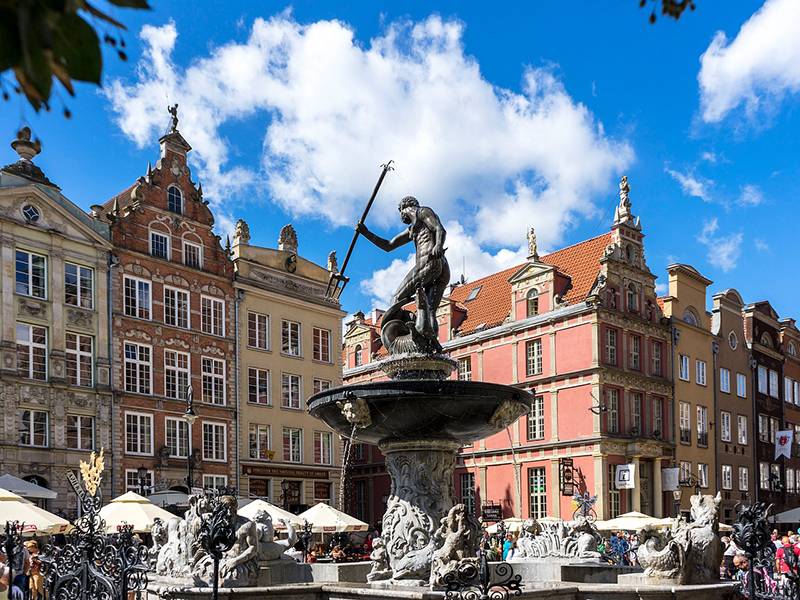Gdansk, the City of Gates

The shaky and tormented nature of Poland’s history is of widespread knowledge: too often does it cover its glorious part and its wonders. The same can be said about its cities, often obscured by the capital, and while the glitz of Warsaw may outshine the rest of the country, a city stands firmly with a proud face: Gdansk, the city of many names and many gates.
Gdansk is a city on the Baltic coast of northern Poland, and the capital of the Pomerania region. It’s notable for having been ruled by many different countries (Poland, Prussia, Germany) as well as for having long periods of autonomy. It was the wealthiest city of Poland before Warsaw’s growth in the 18th century, it was part of the Hanseatic league and as a port city, home of a very important immigration ranging from artists to merchants. During our trip, we got some time to discover a booming locality, ready to welcome the MICE industry with open arms. It’s a testament to Gdansk’s identity, fully committed to preserving its past while thriving for the future.
The Radisson Hotel & Suites
Our first sight was one of majesty and serenity: the 4-star Radisson Hotel & Suites, which granted us the privilege to be hosted in one of its suites, is located right in front of the Motława river. The view from our room was therefore quite impressive, and we could gaze with wonders at the boats slowly gliding away as the streets display a very active life. The hotel itself is a thing to behold: its entrance is covered with amber – the gold of Poland as they say – as are the other rooms. Capable of welcoming 700 delegates in theatre style (350-400 in banquet style) in its 700 m², we were apparently the first MICE press guests they had received since the outbreak of covid-19. The guide tour showed us the conference rooms, all equipped with the most relevant technologies – from the audio-visual system to automatic curtain blinds. There are three meeting rooms (with a capacity of 250 people max), a boardroom, as well as a pre-function ballroom area.
After a first appetiser, we were delighted with a three-course meal – foodies will quickly realise that Gdansk is a heaven of gastronomy, with an extremely diverse offer of food ranging from multinational food court to traditional or high-end cuisine. The Radisson Hotel has different spaces for guests to enjoy their meal. One which caught our eyes is composed of two large ones: a big room for seated dinner, and then above a beautiful, cosier one for conference goers. A perfect setting for more close-up encounters and intimate, face-to-face talks.
One of the most pleasant characteristics of this city is that everything is at a walking distance. It only takes 20 minutes by car to get to the nearest airport, and 20 minutes on foot to go to the European Solidarity Centre and discover another major part of Poland’s history: the Solidarność movement and the role it played in Poland’s liberation. The place itself has a good, albeit not too big, conference room, and in general it’s a nice incentive for people to get to know more about this town. And it would be a sin to miss out on the exhibitions there, with an interior design reminding us of the first local industry back then: boat construction and repair.
Later that evening, we discovered how dynamic our district’s nightlife was, with a lot of locals and Polish tourists and many bars to hang out in. You’d be surprised how much punch the Old Town packs on a Friday night!

Old Town, Gdansk
The City of Gargoyles
Our second day started with an impressive tour of the PURO hotel (4 stars). Suffice it to say that if the Radisson Hotel offered us luxury and classical refinement, this one bluffed us with a very bold, eclectic and elegantly designed architecture. Everything inside is shaped to make a reference to the city’s atmosphere and historical shipyard. Such care and attention to details are quite rare with hotels, which commonly adopt a conventional look and end up all looking the same: here, the desire is to be completely unique and it’s all in the best of taste. Conference rooms all have specific names with different moods (red mouse, granary, etc.); the second floor can be privatised, as well as an incredible rooftop which is also open to the public in the evening.
After this, we enjoyed a very insightful guided tour to the Old Town, with various stories on the fantastic architecture, which reminded me of Bruges as well as some small Dutch towns - heritage of Dutch architects who settled here and brought their style with them. Amongst all of these historical wonders, and the numerous adorable little gargoyles recently placed around the city as landmarks, one statue stands out: Neptune and its trident. Just like any other places in the world, the city has its own legends: two associate the former statue with the creation of the Goldwasser. One says that Neptune got pissed off at the habit of throwing coins into his fountain, struck the water into vodka and smashed the coins into small flakes of gold. Another tells a more positive tale, with a smiling Neptune rewarding the local people by transforming the water into pure vodka to water the whole town.
Then, came the moment to visit the Gdański Shakespeare Theatre. Gdansk is a Shakespearian destination, as it was the place where English travelling companies from the 17th century would come and play. From the outside, one might think it was created by some evil character to become their lair. It’s a completely dark structure, a “black box” per se, made of bricks imported from Belgium, assembled according to Renato Rizzi’s schematics and dedicated to theatre as well as exhibitions. Inside is a completely different story and counterbalances the heaviness of the exterior. It can host from 250 to 400 people for a cocktail, has its own bar – you can even bring your glass inside and drink during the performances, just like it used to be in the past – and uses modern technology to recreate an open-space environment with a retractable roof. Around the latter, the flat surface is large enough to welcome an outside gathering.
Modernity Amongst the Nature
Following this intense cultural half, we immediately hoped in a cab to discover the Olivia Star. A huge skyscraper of 34 floors where the last 3 can be used for MICE events. Beware of the fear of heights! The view is astonishing and you can wander outside to see everything around, from the Forest to the Sea. Each floor has different restaurants, with one in the 33rd overseen by the renowned chef Paco Pérez and aiming for a Michelin star. Amongst them, a tremendous wine collection for the amateurs who share the passion for this divine beverage. On the 34th floor, 850 square metres of functional space can welcome 350 guests, with nearly 6m rooms height that can be used as whole or divided in 3 distinct halls.
Last but not least, we had the pleasure to discover the Novotel Marina Hotel, a cute resort on the shore of the Gdansk Bay, where you can enjoy fish & gin and convert downstairs rooms into events. While it might not be the best place for big conferences, it is nevertheless interesting for smaller events where its numerous corners and activities make for a very family-friendly environment.

All in all, Gdansk is bound to charm you if you give it a chance!
Other Articles
About Us
Supported by the Union of International Associations (UIA), the International Association of Professional Congress Organisers (IAPCO) and the Interel Group, the global public affairs and association management consultancy, Headquarters Magazines serve the needs of international associations organising worldwide congresses.















